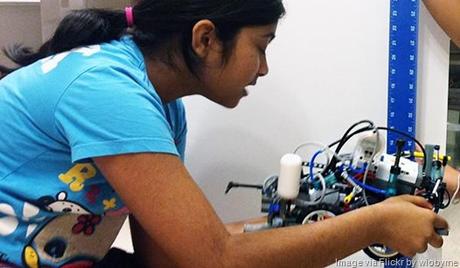 In case you haven’t noticed it, the rapid evolution of do-it-yourself (DIY) facilities for developers, including 3-D printers, SketchUp and makerspaces such as TechShop, have scaled down the cost of prototypes and hardware design by an order of magnitude. This movement, coupled with free websites and apps, makes it possible for almost any technical person to start a business.
In case you haven’t noticed it, the rapid evolution of do-it-yourself (DIY) facilities for developers, including 3-D printers, SketchUp and makerspaces such as TechShop, have scaled down the cost of prototypes and hardware design by an order of magnitude. This movement, coupled with free websites and apps, makes it possible for almost any technical person to start a business.
This Maker Movement has now spread across the world, spawning hundreds of events and companies, including Maker Faires, Makerspaces, Hackerspaces, and Maker Film Fests. This technology is not only spawning a new generation of entrepreneurs, but is also changing the educational landscape, all the way down to early grade school.
In my view as an advisor to new ventures, the Maker Movement is an integral part of a new age of the entrepreneur. This new culture builds on hobbyist technologies, extends the open-source inventory of hardware and software, and bridges the gap into real business solutions with other advantages, as follows:
-
Shortens the time and cost from idea to prototype. In today’s fast moving market, the basic product development cost and time are critical to survival. They come at the early stage while a startup has no revenue or valuation, so professional investors are hard to find. Quick low-cost design and fabrication alternatives are extremely valuable.
-
Facilitates building skills and familiarity with new tools. Makerspaces and hackerspaces have sites and events, including education and training, where people with common interests can meet, socialize and collaborate. With the new rapid prototyping tools, products can be physically built for analysis, rather than just conceptualized.
-
Provides networking with cofounders and strategic partners. Relationships are best built while working and learning together, rather than over drinks at a mixer or industry conference. There are already more than 2000 hackerspaces worldwide, as listed on the Hackerspace Wiki. Countless startup teams have already been spawned from these.
-
Opportunities to meet investors and support organizations. Venture capitalists and investors are where the action is, to see first-hand what is possible, and who are the leaders. Makerspaces are becoming the new incubators and accelerators for startups, and support contacts, including lawyers and marketing groups, will be easy to find.
-
Mind-expanding for new entrepreneurial opportunities. With low-cost digital design and fabrication, such as 3D printing and the ability to digitize almost any object, bold new innovations become apparent. Young entrepreneurs get to “touch and feel” the results, and experiment to their heart’s content. These ideas can grow quickly into real products.
-
Meeting the new consumer demand for customization. Customers today increasingly demand solutions that are customized just for them. Hobbyists and craftsmen have made custom solutions for a very long time, but companies have resisted this requirement to keep costs down. Maker tools are changing these economies of scale.
-
Accelerates the trend to higher purpose startups. The new do-it-yourself capabilities and low entry costs mean that you don’t have be a Bill Gates to offer solutions that have an impact on society. The Maker Movement is already poised to transform learning in our schools, and offer low-cost solutions to solve environmental and third-world problems.
-
Breeds success through people diversity. By collaborating with the Maker Movement, artistic entrepreneurs work with the technology freaks, and both benefit from cultures around the world. New products emerge, as diverse as networked-art installations, Internet-of-Things innovations, and many other hybrid software-hardware solutions.
Now is the time for all you hobbyists and inventors to take the next step and turn your passion into a business. It won’t cost you the many thousands of dollars to outsource your prototype to China, and risk losing the intellectual property, and it will hook you up to peers and investors who can help you make your dream a reality. Now is the time to catch the wave and just do it yourself.

